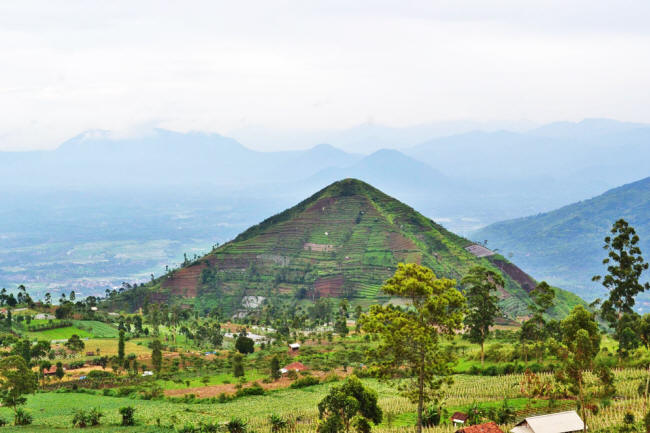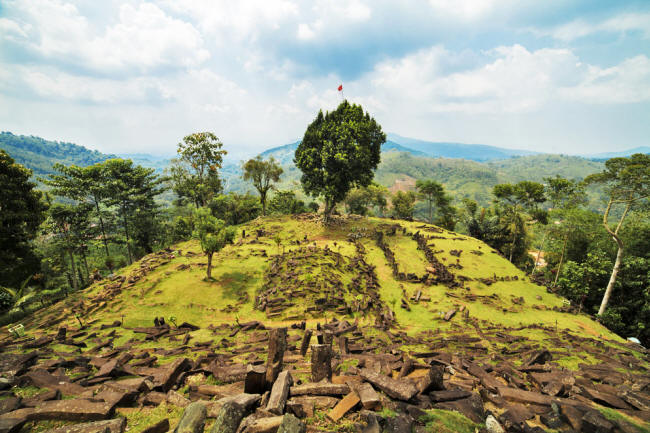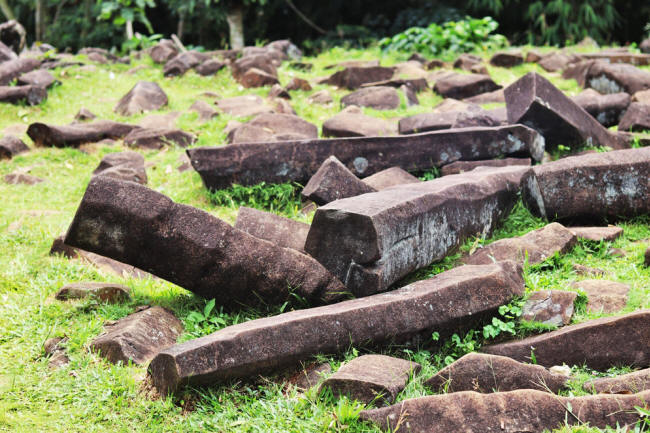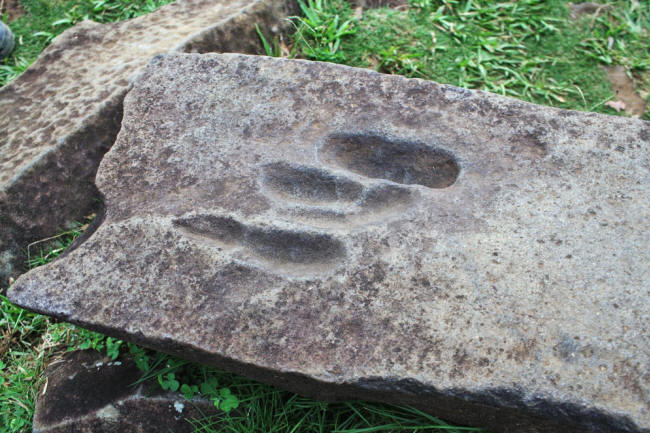|

by Discover Staff
February 28, 2024
from
DiscoverMagazine Website

(Credit: ghanimurtafa/Shutterstock)
Is Gunung Padang
the oldest pyramid in the
world?
Learn about its initial
discovery
and why researchers
still heavily debate its age...
Controversial findings at
Gunung Padang - a massive
Indonesian pyramid sitting on top of an ancient volcano - could flip
everything we thought we knew about prehistory on its head.
If the findings are true, Gunung Padang shows
that Ice Age humans possessed advanced technology, unlike anything
we could have imagined.
Nevertheless, mainstream archeologists are skeptical of these
conclusions, and many have tried to discredit the geologist at the
center of them.
That geologist is Caltech researcher Danny
Hilman Natawidjaja, who has devoted much of his life to an
in-depth geo-archeological survey of this incredible site.
In this article, we explore the archeological wonder of Gunung
Padang and why Natawidjaja believes it's proof of a sophisticated
civilization that flourished up to 27,000 years ago.
When was Gunung Padang Discovered?

Gunung Padang, located in Cianjur,
West Java,
Indonesia
(Credit: Ade
Lukmanul Hakimmm/Shutterstock)
The modern story of Gunung Padang begins in the late 19th
century when Dutch settlers first became aware of the mighty pyramid
just four hours south of Jakarta close to the village of Karyamukti.
According to the writing of Dutch historian
Rogier Verbeek in
1891,
"on the mountain top Goenoeng Padang, near
Goenoeng Melati, a succession of 4 terraces, connected by steps
of rough stone, paved with rough flat stones and decorated with
numerous sharp and columnar upright andesite stones.
On each terrace, a small mound, probably a
grave, surrounded and covered with stones and topped with 2
pointed stones.
In 1890, visited by Mr. De Corte."
Of course, long before the Dutch East India
Company brought slavery and colonialism to West Java, local
inhabitants knew about Gunung Padang and its man-made stone
terraces.
Revering it as 'The Mountain of Enlightenment,'
locals still perform mystical ceremonies at the site, which features
a freshwater spring at its base.
For nearly a century, mainstream
archeologists ignored Gunung Padang.
But in 1979, a group of nearby farmers
brought more attention to the mountain.
Soon, the site became the focus of Indonesian
researchers and archeologists...
Is Gunung Padang the Oldest
Pyramid in the World?

Elongated rock formations piled
together
at the
megalithic site of Gunung Padang
(Credit: Upen
supendi/Shutterstock)
Since the 1980s, a number of in-depth surveys have been conducted at
Gunung Padang, but researchers continue to disagree about its age.
Some claim that the stone constructions date back
to the first millennium A.D., and pottery fragments from the site
were dated to
45 B.C.E to 22 C.E.
Another camp believes that Gunung Padang's age is older.
In 1982, B.M. Kim dated the site to
300 to 2000 B.C.E.
But even these estimates are mild compared to the
most shocking evaluation of them all - that the deepest layers of
Gunung Padang are 16,000 years to 27,000 years old.
That would make Gunung Padang the oldest pyramid
in the world.
This theory - that Gunung Padang dates back to the Ice Age - is
based on the work of geologist Danny Hilman Natawidjaja and his
multidisciplinary team of scientists, archeologists, and volunteers.
From 2011 to 2014, Natawidjaja and his associates
conducted numerous field studies at Gunung Padang including,
-
ground penetrating radar
-
core drilling
-
radiocarbon analysis
With specific regard to the topmost layer of
Gunung Padang, Natawidjaja says he agrees with the conclusions of
B.M. Kim.
"The estimated age of 300 to 2,000 B.C.E. by
B.M. Kim in 1982 aligns with our findings as it likely
corresponds to the stone terraces," says Natawidjaja.
However, he notes that there's another story to
Gunung Padang when you examine the deeper layers of construction.
How the Indonesian Pyramid of
Gunung Padang was Built

Ancient stone from Gunung Padang
site
(Credit: Inpics/Shutterstock)
According to Natawidjaja, the data that supports their findings
shows that the Gunung Padang pyramid is a bit like a three-layer
cake, and each layer was built thousands of years apart.
He says the most recent layer, known as Unit-1,
was constructed about 3,000 years to 4,000
years ago.
The next oldest, Unit-2, was built around
7,500 years to 8,000 years ag
The oldest part of the structure, Unit-3,
could be as ancient as 16,000 years to 27,000 years.
This supports the research done by B.M Kim,
which suggested the pyramid dates back to between 300 and 2,000
B.C.E.
Interestingly, Natawidjaja says,
"Unit-2 may potentially be a stepped
pyramid."
In his 2023 study of the site (Geo-archaeological prospecting of
Gunung Padang buried Prehistoric Pyramid in West Java), he explains that Gunung Padang is more than just an old stone terrace:
it's a complex structure buried underground
featuring large chambers and hollow spaces.
The carbon dating suggests that the initial
construction could have taken place during the last Ice Age, in the
Paleolithic era, and was later modified in the Holocene or Neolithic
era.
Natawidjaja's team came to these conclusions by comparing the ages
of samples from the volcanic base layer (which is millions of years
old) and the three layers of construction.
"In contrast [to the volcano], soil samples
taken from between fragmented rocks have been dated to only a
few thousand to a few tens of thousands of years old, which
presents an enigma in natural geological processes," says
Natawidjaja.
"Geological principles dictate that soils
cannot migrate from the near-surface layers to deeper depths
over time.
Hence, the juxtaposition of relatively young
soils between ancient rock layers poses a significant geological
challenge."
The conclusion:
Only a technologically advanced culture
during the Ice Age could have positioned those stones.
Recognizing the impact of the findings,
Natawidjaja once
told The Sydney Morning Herald,
"It's crazy, but it's data."
The Gunung Padang Controversy - A
Clash of History and Science
If true, the findings at Gunung Padang change everything we thought
we knew about the technological capabilities of humans in
prehistoric times.
Allegedly, this is when humans were only capable
of building small, temporary shelters out of wood, bone, and animal
hides - not megalithic stone structures or stepped pyramids on the
scale of Giza in Egypt.
But this is what we find at Gunung Padang,
where thousands of large stone slabs were
transported from another region and expertly arranged in a grand
work of masonry that appears to be six times older
than the
Pyramid of Giza, and that's
why the site is controversial.
The Gunung
Padang Hoax
Some conventional academics are chomping at the bit to refute
Natawidjaja's conclusions as 'fantastical' or 'sensational' - some
even calling it the "Gunung Padang hoax."
University of Tarragona Researcher Víctor Pérez, wrote a
detailed paper challenging Natawidjaja's findings.
The paper criticizes Natawidjaja's approach,
pointing out what some scientists and academics see as flaws and
mistakes in both the execution and theoretical analysis of their
research.
Pérez argues that,
these issues undermine the credibility of the
ancient dates suggested by Natawidjaja's team, which he claims
lack corroborating archaeological evidence.
Another opposing view comes from professor
Sutikno Bronto of the Center of Geological Survey in Indonesia.
He believes that Gunung Padang is the neck of
a nearby volcano and not an ancient pyramid.
Sutikno argues that the findings of younger soil layers among
older stones and the carbon-dated material at the site do not
substantiate Natawidjaja's claims.
He suggests these are results of natural
erosion, not indicators of human architectural activity.
What Is the Truth About Gunung
Padang?
Natawidjaja stressed that his team's research and surveys were
multidisciplinary (not simply volcanological), and while volcanic
intrusion was indeed present, there's more to the story.
"Our comprehensive study, which includes
geological, archaeological, and geophysical surveys, indeed
confirmed the existence of the underground 'volcanic intrusion'
[…] aligning with Sutikno's observations," Natawidjaja says.
"However, our findings also present
compelling evidence that challenges the perception of Gunung
Padang as simply the neck of a nearby volcano"...
As for the carbon-dated cement mentioned by
Sutikno, Natawidjaja also had other thoughts.
"Our research conclusively demonstrates that
it is indeed a mortar, not a byproduct of natural weathering.
Our team of experienced geologists has
meticulously examined and analyzed the samples, leaving no room
for doubt regarding their origin," says Natawidjaja.
Digging Deeper Into
Gunung Padang's Chambers
Despite the pushback, Natawidjaja seems to
welcome those who challenge his findings.
He points out that the core samples his team
surveyed from Gunung Padang in Indonesia show that the site is
worthy of deeper investigation.
The idea of digging deeper is even more interesting because,
...have already revealed what
appear to be buried chambers and tunnels.
Are these simply caves created by volcanic
processes?
Or, are these deeply hidden Gunung Padang
chambers like the ones buried inside the Pyramid of Giza?
Only a carefully orchestrated excavation can tell
us for sure.
In the meantime, one thing is certain:
the mysteries that veil this
exciting Javanese site will continue to perplex and capture the
imaginations of future generations to come.
For this reason, you might want to hike to the
top of this archeological wonder with an ice-cold thermos of Java
Robusta the next time you're passing through Indonesia...
Video
|





